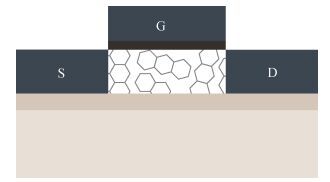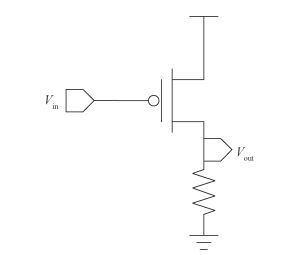| Citation: |
Dongsheng Ma, Zuochang Ye, Yan Wang. Statistically modeling I-V characteristics of CNT-FET with LASSO[J]. Journal of Semiconductors, 2017, 38(8): 084002. doi: 10.1088/1674-4926/38/8/084002
****
D S Ma, Z C Ye, Y Wang. Statistically modeling I-V characteristics of CNT-FET with LASSO[J]. J. Semicond., 2017, 38(8): 084002. doi: 10.1088/1674-4926/38/8/084002.
|
Statistically modeling I-V characteristics of CNT-FET with LASSO
DOI: 10.1088/1674-4926/38/8/084002
More Information
-
Abstract
With the advent of internet of things (IOT), the need for studying new material and devices for various applications is increasing. Traditionally we build compact models for transistors on the basis of physics. But physical models are expensive and need a very long time to adjust for non-ideal effects. As the vision for the application of many novel devices is not certain or the manufacture process is not mature, deriving generalized accurate physical models for such devices is very strenuous, whereas statistical modeling is becoming a potential method because of its data oriented property and fast implementation. In this paper, one classical statistical regression method, LASSO, is used to model the I-V characteristics of CNT-FET and a pseudo-PMOS inverter simulation based on the trained model is implemented in Cadence. The normalized relative mean square prediction error of the trained model versus experiment sample data and the simulation results show that the model is acceptable for digital circuit static simulation. And such modeling methodology can extend to general devices.-
Keywords:
- statistical learning,
- compact model,
- CNT-FET,
- I-V characteristics,
- LASSO,
- machine learning
-
References
[1] Sheu B J, Scharfetter D L, Ko P K, et al. Bsim:Berkeley shortchannel igfet model for mos transistors. IEEE J Solid-State Circuits, 1978, 22(4):558 doi: 10.1007%2F978-3-7091-9247-4_11[2] Waldrop M M. The chips are down for Moore's law. Nature, 2016, 530(7589):144 doi: 10.1038/530144a[3] Qiu C G, Zhang Z Y, Xiao M M, et al. Scaling carbon nanotube complementary transistors to 5-nm gate lengths. Science, 2017, 355(6322):271 doi: 10.1126/science.aaj1628[4] Boland C S, Khan U, Ryan G, et al. Sensitive electromechanical sensors using viscoelastic graphene-polymer nanocomposites. Science, 2016, 354(6317):1257 doi: 10.1126/science.aag2879[5] Bandurin D A, Tyurnina A V, Yu G L, et al. High electron mobility, quantum hall effect and anomalous optical response in atomically thin inse. Nate Nanotechnol, 2016, 12:223 doi: 10.1038/nnano.2016.242[6] Avouris P, Chen Z H, Perebeinos V. Carbon-based electronics. Nat Nanotechnol, 2017, 2(10):605[7] Che Y C, Chen H T, Gui H, et al. Review of carbon nanotube nanoelectronics and macroelectronics. Semicond Sci Technol, 2014, 29(7):073001 doi: 10.1088/0268-1242/29/7/073001[8] Franklin A D, Luisier M, Han S J, et al. Sub-10 nm carbon nanotube transistor. Nano Lett, 2012, 12(2):758 doi: 10.1021/nl203701g[9] Chen B Y, Zhang P P, Ding L, et al. Highly uniform carbon nanotube field-effect transistors and medium scale integrated circuits. Nano Lett, 2016, 16(8):5120 doi: 10.1021/acs.nanolett.6b02046[10] Sinha S K, Chaudhury S. Comparative study of leakage power in cntfet over mosfet device. J Semicond, 2014, 35(11):114002 doi: 10.1088/1674-4926/35/11/114002[11] Shulaker M M, Hills G, Patil N, et al. Carbon nanotube computer. Nature, 2013, 501(7468):526 doi: 10.1038/nature12502[12] Claus M, Fediai A, Mothes S, et al. Towards a multiscale modeling framework for metal-CNT interfaces. 2014 International Workshop on Computational Electronics (IWCE), 2014:1 https://www.researchgate.net/publication/269273284_Towards_a_multiscale_modeling_framework_for_metal-CNT_interfaces[13] Akbari E, Buntat Z, Enzevaee A, et al. Analytical modeling and simulation of I-V characteristics in carbon nanotube based gas sensors using ann and svr methods. Chemometrics and Intelligent Laboratory Systems, 2014, 137:173 doi: 10.1016/j.chemolab.2014.07.001[14] Tibshirani R. Regression shrinkage and selection via the lasso. J Royal Statist Soci B, 1996, 58(1):267 http://research.cs.rutgers.edu/~jzhuang/teaching/Lasso_TinglinLiu.ppt[15] Friedman J, Hastie T, Tibshirani R. The elements of statistical learning. Volume 1. Berlin: Springer, 2001[16] Miller A. Subset selection in regression. CRC Press, 2002 -
Proportional views






 DownLoad:
DownLoad:

















